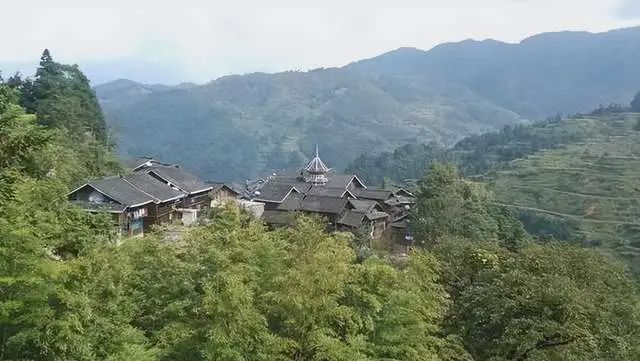Ethnic villages are among China’s most popular tourist attractions, but visiting them often presents a dilemma. Well-developed sites can feel overcrowded and overly commercialized, lacking authenticity. On the other hand, undeveloped villages may have poor transportation and infrastructure.

Faced with this predicament, tourists often struggle to make a choice. To address this issue, Guizhou Province has created a cluster of Dong villages, combining mature scenic areas with surrounding smaller hamlets. This allows visitors to experience different types of villages within a single scenic area. This innovative approach is exemplified by the Zhaoxing Dong Village Cluster.
Located in Liping County in the southeastern corner of Guizhou Province, the Zhaoxing Dong Village Cluster is just a few kilometers from Congjiang High-Speed Railway Station. The cluster is part of Zhaoxing Town. In recent years, Zhaoxing Town has connected Zhaoxing Dong Village with nearby villages such as Tang’an, Xiage Upper Village, Xiage Lower Village, Jitang, Shangdiping, Dengjiang, and Jilun to create the “Eight Villages of Zhaoxing” scenic area. Visitors can reach the surrounding smaller villages on foot after arriving in Zhaoxing.

Zhaoxing Dong Village is the core of the scenic area and the largest Dong village in China. It’s also one of the most developed villages, second only to Xijiang Miao Village. As the town center of Zhaoxing, it’s also known as “Zhaoxing Ancient Town.” In 2005, it was selected by “China National Geographic” as one of the “Six Most Beautiful Rural Ancient Towns in China.” Direct tourist buses from Congjiang Station to Zhaoxing Dong Village make access very convenient.

All residents of Zhaoxing Dong Village belong to the Lu surname of the Dong ethnic group, divided into five major family clans living in five natural areas locally called “tuan.” These are Ren Tuan, Yi Tuan, Li Tuan, Zhi Tuan, and Xin Tuan. Zhaoxing Dong Village is famous for its drum tower clusters, which are unique among Dong villages nationwide, earning it the title “Home of Drum Tower Culture and Art.”



Due to its early development, Zhaoxing town is lined with shops, hotels, and guesthouses, making it the ideal place for tourists to stay and dine. During peak seasons, Zhaoxing Ancient Town can get crowded, diminishing the tourist experience. At such times, visitors can explore the nearby smaller villages.

Tang’an Dong Village
The most famous small Dong village is Tang’an, located 7.5 kilometers from Zhaoxing. A stone path connects the two, offering beautiful terraced field scenery along the way, making it an excellent hiking route. Tang’an Dong Village is home to over 160 Dong households, with more than 800 residents. The village’s drum towers, opera stages, stilt houses, stone paths, ancient tomb clusters, ancient dipper wells, as well as water mills, stone mortars, and spinning wheels all reflect the lifestyle of the Dong people.
In 1999, Tang’an Village established the Guizhou Liping Tang’an Dong Ethnic Eco-Museum. There are also restaurants and homestays in Tang’an Dong Village, providing a quieter alternative for those seeking a more peaceful stay.



Jitang Dong Village
Jitang Dong Village is located just 2.5 kilometers from Zhaoxing Town, situated on the main street of Jitang Village. The village is positioned on a hillside, forming a triangular settlement. It was established in 1538 when residents from Zhaoxing Village relocated here. According to legend, this area was once covered in dense forests with a pond in the mountains. In the Dong language, “ji” means mountain ridge, and “tang” means pond, hence the name “Jitang.”



Besides Jitang Dong Village, Jitang Village also includes several natural hamlets such as Dengjiang, Zailiu, and Laima. Among these, Laima Dong Village is considered the most beautiful. Nestled between mountains and surrounded by dense forests, Laima boasts an excellent natural environment. The village’s well-preserved buildings give it a feeling of a hidden paradise.


Laima Dong Village
Dengjiang Dong Village is 6 kilometers from Zhaoxing Town, situated on a hilltop. The village features one drum tower, two village gates, one opera stage, and ten ancient stilt house residences. In 2013, both Jitang Dong Village and Dengjiang Dong Village were included in the tentative list for UNESCO World Heritage Site application by the National Cultural Heritage Administration of China.


Dengjiang Dong Village
Xiage Village is located 2.5 kilometers from Zhaoxing Dong Village and is divided into upper and lower sections. Tourists hiking to Tang’an can pass through Xiage Dong Village. However, most of the traditional architecture in this village has been destroyed, with very few stilt houses remaining. Most buildings have been replaced by concrete structures, so tourists may choose to skip this village.


Shangdiping Dong Village
Shangdiping Dong Village is 7.5 kilometers from Zhaoxing Town, situated in a valley between steep cliffs. This ancient village has a long history, with seven clans of the same surname living here for over 500 years. The houses are all wooden three-story stilt structures, with some centuries-old houses still featuring traditional “guoshou” window lattices, exemplifying typical Dong village characteristics. Shangdiping has also been recognized as one of the four civilized villages by Liping County.



Jilun Dong Village
Jilun Dong Village is located on the hillside adjacent to Zhaoxing Dong Village and can be reached within an hour’s walk from Zhaoxing. From the concrete road next to Zhituan Drum Tower in Zhaoxing, it takes about 20 minutes on foot to reach Jilun. Along the way, visitors can enjoy a bird’s-eye view of the Dong ethnic song and dance performance area, which offers a pleasant visual experience. Jilun Dong Village receives very few tourists, but elderly, hunched women still wait with their handicrafts for the occasional visitor. The village is small but well-organized, with buildings constructed to fit the terrain, creating a charming and delicate atmosphere.



Jilun Dong Village
While the “Eight Villages of Zhaoxing” are representative of the area, there are actually Dong villages scattered throughout Zhaoxing Town. Visitors will encounter many more small Dong villages during their hikes. These villages are typically located deep in the mountains, with limited accessibility and few visitors. The Zhaoxing Dong Village cluster is particularly suitable for hiking enthusiasts, with the entire route potentially covering dozens of kilometers. Casual tourists can choose to explore a few selected villages, which may involve just a few kilometers of walking. Alternatively, visitors can take a vehicle from Zhaoxing to reach Tang’an Dong Village.


The development model of Zhaoxing is commendable and worth learning from by more established ethnic villages like Xijiang. Imagine if Xijiang were to incorporate nearby small Miao villages like Kongbai into its tourism offerings – wouldn’t that enhance the overall experience? We might call this approach the “Zhaoxing model” of development.
However, the Zhaoxing model also has several drawbacks. Firstly, in an attempt to bundle the small Dong villages with Zhaoxing for tourism purposes, the authorities have cut off transportation links between these smaller villages and surrounding areas, prohibiting outside tourists from entering freely. This shows a desire for quick profits. Previously, visitors could freely enter Tang’an Dong Village without a ticket, but now they must purchase an 80 yuan ticket for the Zhaoxing scenic area to gain entry, which is an unreasonable policy.
Secondly, as a designated scenic area, there should be shuttle services available. Tourists have limited energy and may find it challenging to visit all eight small villages on foot. The scenic area should introduce a circular shuttle service to the eight villages, allowing tourists to hop on and off at any point, making round trips more convenient. This would effectively promote the development of other small Dong villages, increase the tourist capacity of the scenic area, and enhance the overall visitor experience.





